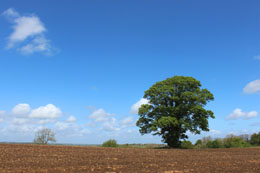There are various interesting facts associated with the sycamore tree, highlighting its physical features, characteristics, and history. Read this article to learn more about some fascinating facts about this tree.

The scientific name of sycamore tree is
Platanus Occidentalis. It is also often referred to as American sycamore tree. It belongs to the family of
Platanaceae which is one of the oldest tree family of the world. Various scientific evidences suggest that this tree family is existing on the earth for more than 100 million years. You will be surprised to know that sycamore is native to Central Europe but today, it has disappeared from there. Another amazing fact about this tree is that on an average, it lives for almost six hundred years!
Identification
Sycamore trees are easily identified with their giant size. It can grow as tall as 30 - 40 meters (or 98 to 130 ft), and its diameter can be as big as 1.5 - 2 meters (or 4.9 to 6.6 ft).
The distinguishing feature of this tree is its bark. It has patches of creamy white and reddish-brown color all over its surface. The dark-colored bark is the part of the old tree and the light color is the fresh bark. It is believed that the tree has got its name "Sycamore" because of these peeling flakes of its bark which make it look 'sick' all the time!
The leaves are broad and flat with sharp uneven edges. The size of the leaves varies from 4 - 6 inches in length. The tree shed its leaves in autumn and new leaves come in spring. Its fruits appear as a brownish woody ball that ripe in the month of October. It will hang from the tree all through the winter months and then break into seeds.
Planting Facts
As you have already learned that sycamore tree has a huge size. Hence, it requires a large landscaping. In other words, it can grow only in a vast landscape. It cannot be planted in small house gardens. The light requirements of the tree is vital for its healthy growth. It requires exposure to full sun. Insufficient light can have a negative impact on its health. The favorable temperature range for this tree is 40 - 70 degrees Fahrenheit. The annual precipitation requirement is 30 - 80 inches. It prefers nutrient rich, moist soil conditions with proper drainage for its growth. For this reason, they mostly grow near rivers and streams and in bottom lands. However, it is intolerant towards flooding of the soil during its growing season.
Regular watering is a must for a newly planted sycamore. This is because, if the soil dries out, then the plant is prone to pest infestation. Nitrogen-rich fertilizer is most suitable for this tree. In winter months, its roots should be protected from heavy frosts by covering up the soil with two inches thick layer of mulch. The upward shoots of a young sycamore should be pruned every winter to keep the plant in shape. The diseased and damaged portions of the tree can be trimmed throughout the year. When all its growing requirements are fulfilled, the tree will reach its maturity quite rapidly. In a span of twenty years, it can reach a height of 100 feet!
Symbolism
As sycamore tree is one of the oldest species of trees on this earth, it has a lot of historical significance. It is considered as a symbol of strength, protection, eternity, and divinity. In Egypt, it is portrayed as representation of Egyptian goddesses in the book named "Book of the Dead". It has its reference in Bible as well. In America, during the Battle of Brandywine in 1777, one 168 years old sycamore tree in Brandywine Battlefield Park, Pennsylvania, sheltered large troops of General Washington. Since then, it became a symbol of protection and hope for the Americans.
Hope the facts provided in this article have enriched your knowledge about this unique tree. It's not just well-known for its physical characteristics and historical value. It has various uses too. As these trees are broad, it gives us an excellent shade. Its timber is tough and is hard to split. Hence, it is used for making furniture, musical instruments, butcher blocks, etc.






 The scientific name of sycamore tree is Platanus Occidentalis. It is also often referred to as American sycamore tree. It belongs to the family of Platanaceae which is one of the oldest tree family of the world. Various scientific evidences suggest that this tree family is existing on the earth for more than 100 million years. You will be surprised to know that sycamore is native to Central Europe but today, it has disappeared from there. Another amazing fact about this tree is that on an average, it lives for almost six hundred years!
The scientific name of sycamore tree is Platanus Occidentalis. It is also often referred to as American sycamore tree. It belongs to the family of Platanaceae which is one of the oldest tree family of the world. Various scientific evidences suggest that this tree family is existing on the earth for more than 100 million years. You will be surprised to know that sycamore is native to Central Europe but today, it has disappeared from there. Another amazing fact about this tree is that on an average, it lives for almost six hundred years!